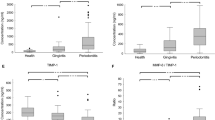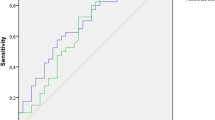Abstract
Aim
To evaluate the expression of salivary and serum Insulin-like growth factor-1 (IGF-1) and Insulin-like growth factor binding protein-3 (IGFBP-3) in individuals with and without diabetes and oral cancer.
Methods
The cross-sectional study included 4 groups (n = 12/group). Group I consisted of healthy individuals (controls), Group II individuals with type 2 diabetes (T2D) without oral cancer, Group III individuals had only oral cancer and Group IV individuals had oral cancer and T2D. Demographic characteristics and biochemical values were recorded. Salivary and serum IGF-1 and IGFBP-3 were measured using a quantitative sandwich ELISA technique.
Results
Serum IGF-1 levels [Median (Inter-quartile range)] were highest among the control group [255 (135) ng/ml], followed by only T2D group [210 (147) ng/ml], oral cancer with T2D group [149 (45) ng/ml] and finally the oral cancer group [143 (81) ng/ml, p for trend = 0.004]. Salivary IGF-1 values were significantly higher in both the groups with T2D [T2D:0.42 (0.20) ng/ml; oral cancer with T2D: 0.40 (0.21) ng/ml] when compared to those with only oral cancer [0.27 (0.06) ng/ml] and controls: 0.17 (0.17) ng/ml], p for trend = 0.007]. Serum IGFBP-3 was significantly higher in both the oral cancer groups [without T2D: 13.1(10.4) ng/ml; with T2D: 14.9 (8.5) ng/ml] compared to only T2D [0.27 (0.06) ng/ml] and controls [8.7 (3.5) ng/ml, p for trend = 0.001]. However, no significant trend was observed in salivary IGFBP-3 levels.
Conclusion
IGF-1 and IGFBP-3 are not reliable biomarkers for oral cancer screening or risk prediction. Further research is needed to confirm if they can be used as prognostic tools during treatment.


Similar content being viewed by others
References
Sung H, Ferlay J, Siegel RL, Laversanne M, Soerjomataram I, Jemal A et al (2021) Global cancer statistics 2020: globocan estimates of incidence and mortality worldwide for 36 cancers in 185 countries. CA Cancer J Clin 71:209–249. https://doi.org/10.3322/caac.21660
Cancer Tomorrow n.d. https://gco.iarc.who.int/today/ Accessed 4 Mar 2024
Warnakulasuriya S, Sutherland G, Scully C (2005) Tobacco, oral cancer, and treatment of dependence. Oral Oncol 41:244–260. https://doi.org/10.1016/j.oraloncology.2004.08.010
Endogenous Hormones and Breast Cancer Collaborative Group, Key TJ, Appleby PN, Reeves GK, Roddam AW (2010) Insulin-like growth factor 1 (IGF1), IGF binding protein 3 (IGFBP3), and breast cancer risk: pooled individual data analysis of 17 prospective studies. Lancet Oncol 11:530–542. https://doi.org/10.1016/S1470-2045(10)70095-4
Slomiany MG, Black LA, Kibbey MM, Day TA, Rosenzweig SA (2006) IGF-1 induced vascular endothelial growth factor secretion in head and neck squamous cell carcinoma. Biochem Biophys Res Commun 342:851–858. https://doi.org/10.1016/j.bbrc.2006.02.043
Kim MS, Lee D-Y (2015) Insulin-like growth factor (IGF)-I and IGF binding proteins axis in diabetes mellitus. Ann Pediatr Endocrinol Metab 20:69–73. https://doi.org/10.6065/apem.2015.20.2.69
Lee H-J, Lee J-S, Hwang SJ, Lee H-Y (2015) Insulin-like growth factor binding protein-3 inhibits cell adhesion via suppression of integrin β4 expression. Oncotarget 6:15150–15163
Rajpathak SN, Gunter MJ, Wylie-Rosett J, Ho GYF, Kaplan RC, Muzumdar R et al (2009) The role of insulin-like growth factor-I and its binding proteins in glucose homeostasis and type 2 diabetes. Diabetes Metab Res Rev 25:3. https://doi.org/10.1002/dmrr.919
Ramos-Garcia P, Roca-Rodriguez MDM, Aguilar-Diosdado M, Gonzalez-Moles MA (2021) Diabetes mellitus and oral cancer/oral potentially malignant disorders: a systematic review and meta-analysis. Oral Dis 27:404–421. https://doi.org/10.1111/odi.13289
Gong Y, Wei B, Yu L, Pan W (2015) Type 2 diabetes mellitus and risk of oral cancer and precancerous lesions: a meta-analysis of observational studies. Oral Oncol 51:332–340. https://doi.org/10.1016/j.oraloncology.2015.01.003
Sample size of 12 per group rule of thumb for a pilot study—Julious (2005) Pharmaceutical statistics. Wiley Online Library n.d. https://onlinelibrary.wiley.com/doi/abs/https://doi.org/10.1002/pst.185. Accessed 26 April 2024
Zanoni DK, Patel SG, Shah JP (2019) Changes in the 8th edition of the american joint committee on cancer (AJCC) staging of head and neck cancer rationale and implications. Curr Oncol Rep 21:52. https://doi.org/10.1007/s11912-019-0799-x
World Health Organization (2013) International classification of diseases for oncology (ICD-O), 3rd edn. World Health Organization, Geneva
American Diabetes Association (2022) Standards of medical care in diabetes—2022 abridged for primary care providers. Clin Diabetes 40:10–38. https://doi.org/10.2337/cd22-as01
James PA, Oparil S, Carter BL, Cushman WC, Dennison-Himmelfarb C, Handler J et al (2014) Evidence-based guideline for the management of high blood pressure in adults: report from the panel members appointed to the eighth joint national committee (JNC 8). JAMA 311:507–520. https://doi.org/10.1001/jama.2013.284427
Wang X, Wang H, Zhang T, Cai L, Dai E, He J (2020) Diabetes and its potential impact on head and neck oncogenesis. J Cancer 11:583–591. https://doi.org/10.7150/jca.35607
Frantsiyants EM, Surikova EI, Kaplieva IV, Bandovkina VA, Neskubina IV, Sheiko EA et al (2021) Diabetes mellitus and cancer: a system of insulin-like growth factors. Probl Endokrinol (Mosk) 67:34–42. https://doi.org/10.14341/probl12741
Kalfert D, Ludvikova M, Topolcan O, Celakovsky P, Kucera R, Windrichova J et al (2017) Serum levels of IGF-1 and IGFBP-3 in relation to clinical and pathobiological aspects of head and neck squamous cell carcinomas. Anticancer Res 37:3281–3286. https://doi.org/10.21873/anticanres.11693
Brady G, O’Regan E, Miller I, Ogungbowale A, Kapas S, Crean SJ (2007) Serum levels of insulin-like growth factors (IGFs) and their binding proteins (IGFBPs), -1, -2, -3, in oral cancer. Int J Oral Maxillofac Surg 36:259–262. https://doi.org/10.1016/j.ijom.2006.09.009
Murphy N, Carreras-Torres R, Song M, Chan AT, Martin RM, Papadimitriou N et al (2020) Circulating levels of insulin-like growth factor 1 and insulin-like growth factor binding protein 3 associate with risk of colorectal cancer based on serologic and mendelian randomization analyses. Gastroenterology 158:1300-1312.e20. https://doi.org/10.1053/j.gastro.2019.12.020
Teppala S, Shankar A (2010) Association between serum IGF-1 and diabetes among U.S. adults. Diabetes Care 33:2257–2259. https://doi.org/10.2337/dc10-0770
Aneke-Nash CS, Xue X, Qi Q, Biggs ML, Cappola A, Kuller L et al (2017) The association between IGF-I and IGFBP-3 and incident diabetes in an older population of men and women in the cardiovascular health study. J Clin Endocrinol Metab 102:4541–4547. https://doi.org/10.1210/jc.2017-01273
Qian F, Huo D (2020) Circulating insulin-like growth factor-1 and risk of total and 19 site-specific cancers: cohort study analyses from the UK biobank. Cancer Epidemiol Biomarkers Prev 29:2332–2342. https://doi.org/10.1158/1055-9965.EPI-20-0743
Larsson SC, Carter P, Vithayathil M, Kar S, Mason AM, Burgess S (2020) Insulin-like growth factor-1 and site-specific cancers: a Mendelian randomization study. Cancer Med 9:6836–6842. https://doi.org/10.1002/cam4.3345
Grimberg A (2003) Mechanisms by which IGF-I may promote cancer. Cancer Biol Ther 2:630–635
Tiwari SK, Saini S, Singhal P, Mathur A, Sinha M (2020) The diagnostic and prognostic utility of insulin growth factor of squamous cell carcinoma in oral cavity. Tzu Chi Med J 33:160–164. https://doi.org/10.4103/tcmj.tcmj_50_20
Schiegnitz E, Kämmerer PW, Schön H, Gülle C, Berres M, Sagheb K et al (2017) The matrix metalloproteinase and insulin-like growth factor system in oral cancer - a prospective clinical study. Onco Targets Ther 10:5099–5105. https://doi.org/10.2147/OTT.S149231
Shpitzer T, Bahar G, Feinmesser R, Nagler RM (2007) A comprehensive salivary analysis for oral cancer diagnosis. J Cancer Res Clin Oncol 133:613–617. https://doi.org/10.1007/s00432-007-0207-z
Zhi X, Lamperska K, Golusinski P, Schork NJ, Luczewski L, Golusinski W et al (2014) Expression levels of insulin-like growth factor 1 and 2 in head and neck squamous cell carcinoma. Growth Horm IGF Res 24:137–141. https://doi.org/10.1016/j.ghir.2014.04.003
Ferreira Mendes JM, de Faro VL, Torres Andion Vidal M, Paredes BD, Coelho P, Allahdadi KJ et al (2020) Effects of IGF-1 on proliferation, angiogenesis, tumor stem cell populations and activation of AKT and hedgehog pathways in oral squamous cell carcinoma. Int J Mol Sci 21:6487. https://doi.org/10.3390/ijms21186487
Luo Y, Hong C-Q, Huang B-L, Ding T-Y, Chu L-Y, Zhang B et al (2022) Serum insulin-like growth factor binding protein-3 as a potential biomarker for diagnosis and prognosis of oesophageal squamous cell carcinoma. Ann Med 54:2153–2166. https://doi.org/10.1080/07853890.2022.2104921
Joseph BK, Sundaram DB (2011) Insulin-like growth factor-1 receptor expression in oral squamous cell carcinoma. J Clin Exp Invest. https://doi.org/10.5799/ahinjs.01.2011.04.0071
Zhang Y, Gao C, Cao F, Wu Y, Chen S, Han X et al (2021) Pan-cancer analysis of IGF-1 and IGF-1R as potential prognostic biomarkers and immunotherapy targets. Front Oncol 11:755341. https://doi.org/10.3389/fonc.2021.755341
Acknowledgements
The authors thank the participants for their involvement in this study.
Funding
The authors acknowledge the Research Society for the Study of Diabetes in India (RSSDI) for the financial support for the study through their research grant (project no.RSSDI/HQ/Grants/2021/10).
Author information
Authors and Affiliations
Corresponding author
Ethics declarations
Conflict of interest
None.
Additional information
Publisher's Note
Springer Nature remains neutral with regard to jurisdictional claims in published maps and institutional affiliations.
Rights and permissions
Springer Nature or its licensor (e.g. a society or other partner) holds exclusive rights to this article under a publishing agreement with the author(s) or other rightsholder(s); author self-archiving of the accepted manuscript version of this article is solely governed by the terms of such publishing agreement and applicable law.
About this article
Cite this article
Abhinav, R.P., Bennett, C.M., Anjana, R.M. et al. Expression of Salivary and Serum IGF-1 and IGFBP-3 in Individuals With Diabetes and Oral Cancer. J. Maxillofac. Oral Surg. (2024). https://doi.org/10.1007/s12663-024-02212-6
Received:
Accepted:
Published:
DOI: https://doi.org/10.1007/s12663-024-02212-6




